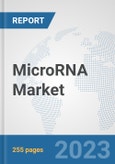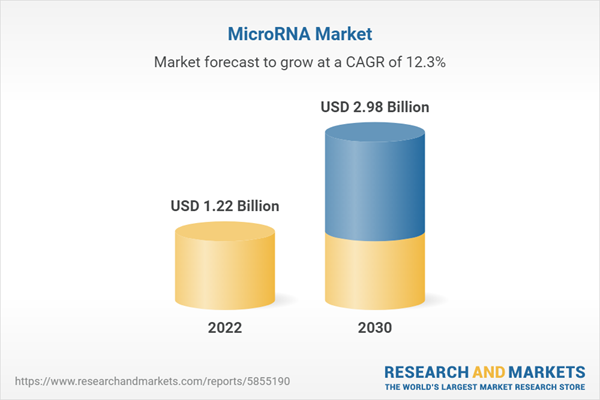The class of tiny, highly conserved non-coding RNA molecules known as microRNAs (miRNAs) is essential for the control of gene expression. RNA polymerases II and III transcribe them, producing precursors that go through a series of cleavage events to become mature miRNAs. These mature miRNAs are typically 18-25 nucleotides in length. Unlike traditional coding RNAs, miRNAs do not encode proteins. Instead, they function as post-transcriptional regulators of gene expression. By binding to messenger RNAs (mRNAs), miRNAs can modulate the functions of other genes involved in protein synthesis. They act by either inhibiting mRNA translation or promoting mRNA degradation, thereby fine-tuning gene expression levels. The market for miRNAs is experiencing growth driven by the increasing number of clinical trials targeting chronic diseases.
Cancer is to experience dominance in the application segment of the microRNA (miRNA) market. miRNAs have demonstrated tremendous promise in the study of diagnosis, prognosis, and therapy of cancer. Due to significant investments in cancer research and the adoption of miRNA signatures, the highest revenue share was achieved. MicroRNAs (miRNAs) have various advantages over invasive testing and show potential as diagnostic biomarkers for cancer. They can be found in a variety of biofluids, such as blood, urine, and tissue samples, making it possible to use quick and simple testing procedures. The existence of particular miRNA signatures can offer important insights into cancer risk assessment, early cancer detection, and cancer subtype distinction. Healthcare providers can increase the accuracy of cancer detection and hence improve patient outcomes by utilizing miRNA profiles.
North America is to experience dominance in the region segment in the global microRNA (miRNA) market due to several key factors. The region's dominance is driven by the presence of key players and a strong research and development (R&D) infrastructure in the life sciences and biotechnology sectors. With leading academic institutions, research organizations, and biotech companies making substantial investments in miRNA research, North America has witnessed scientific advancements and fostered innovation in the field. Furthermore, North America, particularly the United States, boasts one of the highest healthcare expenditures worldwide. This significant investment in healthcare infrastructure, research, and development further propels the growth of the miRNA market in the region. The availability of substantial financial resources enables healthcare providers to adopt advanced diagnostic technologies and therapies, including miRNA-based approaches. Collaboration and partnerships between academic institutions, industry players, and research organizations also play a crucial role in North America's dominance. These collaborative efforts facilitate knowledge exchange, technology transfer, and the commercialization of miRNA-based products. The region's strong culture of collaboration accelerates research and development, leading to market growth.
Report Findings
1) Drivers
- The market is experiencing growth as more clinical trials for chronic diseases are conducted.
- The market for miRNA-based products and services is driven by the need for precise and early diagnosis, as well as for tailored therapeutics.
2) Restraints
- The factor which restrains the market growth is safety and toxicity issues in the services.
3) Opportunities
- The advancement in the technology creates an opportunity in the market, the discovery of novel miRNAs, identification of miRNA targets, and characterization of miRNA function are all made possible by Next-generation Sequencing (NGS) techniques.
Research Methodology
A) Primary Research
The primary research involves extensive interviews and analysis of the opinions provided by the primary respondents. The primary research starts with identifying and approaching the primary respondents, the primary respondents are approached include1. Key Opinion Leaders
2. Internal and External subject matter experts
3. Professionals and participants from the industry
The primary research respondents typically include
1. Executives working with leading companies in the market under review2. Product/brand/marketing managers
3. CXO level executives
4. Regional/zonal/country managers
5. Vice President level executives.
B) Secondary Research
Secondary research involves extensive exploring through the secondary sources of information available in both the public domain and paid sources. Each research study is based on over 500 hours of secondary research accompanied by primary research. The information obtained through the secondary sources is validated through the crosscheck on various data sources.The secondary sources of the data typically include
1. Company reports and publications2. Government/institutional publications
3. Trade and associations journals
4. Databases such as WTO, OECD, World Bank, and among others.
5. Websites and publications by research agencies
Segment Covered
The global microRNA market is segmented on the basis of product and service, application, and end user.The Global MicroRNA Market by Product and Service
- Profiling
- Localization
- Quantification
The Global MicroRNA Market by Application
- Cancer
- Neurological Disease
The Global MicroRNA Market by End User
- Pharma & Biotech Companies
- Academic & Research Institutes
- Healthcare Facilities
- Others
Company Profiles
The companies covered in the report include- Merck KGaA
- Thermo Fisher Scientific Inc.
- Horizon Discovery Ltd.
- QIAGEN
- GeneCopoeia, Inc.
- New England Biolabs
- Quantabio
- NanoString Technologies, Inc.
- BioGenex
- SeqMatic LLC.
What does this Report Deliver?
1. Comprehensive analysis of the global as well as regional markets of the microRNA market.2. Complete coverage of all the segments in the microRNA market to analyze the trends, developments in the global market and forecast of market size up to 2030.
3. Comprehensive analysis of the companies operating in the global microRNA market. The company profile includes analysis of product portfolio, revenue, SWOT analysis and latest developments of the company.
4. Growth Matrix presents an analysis of the product segments and geographies that market players should focus to invest, consolidate, expand and/or diversify.
Table of Contents
Companies Mentioned
- Merck KGaA
- Thermo Fisher Scientific Inc.
- Horizon Discovery Ltd.
- QIAGEN
- GeneCopoeia, Inc.
- New England Biolabs
- Quantabio
- NanoString Technologies, Inc.
- BioGenex
- SeqMatic LLC.
Table Information
| Report Attribute | Details |
|---|---|
| No. of Pages | 255 |
| Published | July 2023 |
| Forecast Period | 2022 - 2030 |
| Estimated Market Value ( USD | $ 1.22 Billion |
| Forecasted Market Value ( USD | $ 2.98 Billion |
| Compound Annual Growth Rate | 12.2% |
| Regions Covered | Global |
| No. of Companies Mentioned | 10 |









